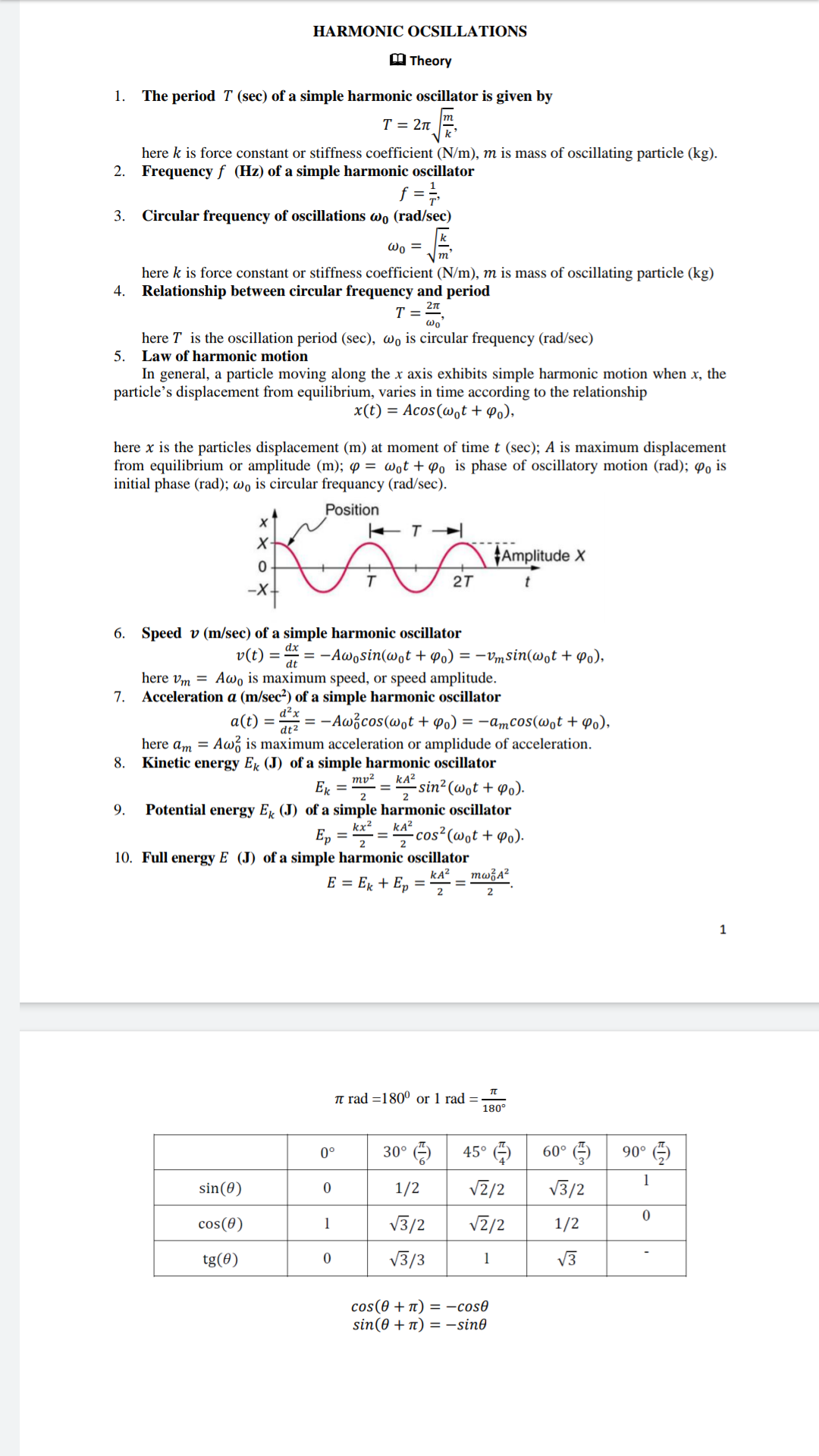
College Physics
11th Edition
ISBN: 9781305952300
Author: Raymond A. Serway, Chris Vuille
Publisher: Cengage Learning
expand_more
expand_more
format_list_bulleted
Question

Transcribed Image Text:HARMONIC OCSILLATIONS
M Theory
1.
The period T (sec) of a simple harmonic oscillator is given by
Т% 2л
here k is force constant or stiffness coefficient (N/m), m is mass of oscillating particle (kg).
Frequency f (Hz) of a simple harmonic oscillator
2.
f =
3.
Circular frequency of oscillations wo (rad/sec)
here k is force constant or stiffness coefficient (N/m), m is mass of oscillating particle (kg)
Relationship between circular frequency and period
4.
2л
T =-
here T is the oscillation period (sec), wo is circular frequency (rad/sec)
5. Law of harmonic motion
In general, a particle moving along the x axis exhibits simple harmonic motion when x, the
particle's displacement from equilibrium, varies in time according to the relationship
x (t) 3 Асos(0ot + Ф),
here x is the particles displacement (m) at moment of time t (sec); A is maximum displacement
from equilibrium or amplitude (m); p = wot + Po is phase of oscillatory motion (rad); 4o is
initial phase (rad); wo is circular frequancy (rad/sec).
Position
х
X-
Amplitude X
-X
Speed v (m/sec) of a simple harmonic oscillator
6.
dx
v(t) =
= -Awosin(@,t + Po) = -vmSin(@ot + Po),
here vm = Awo is maximum speed, or speed amplitude.
Acceleration a (m/sec²) of a simple harmonic oscillator
d?x
7.
= -Awžcos(wot + 4o) = -amcos(wot + Po),
here am = Aw is maximum acceleration or amplidude of acceleration.
a(t) =
dt2
8.
Kinetic energy E (J) of a simple harmonic oscillator
kA?
sin²(wot + Po).
ту?
2
9.
Potential energy E, (J) of a simple harmonic oscillator
kx2
E, = =
kA?
- cos²(wot + Po).
%3D
10. Full energy E (J) of a simple harmonic oscillator
тозА?
kA²
E = Ex + Ep
%3D
T rad =180° or 1 rad =
180°
30° G
60° ()
90° G)
45° )
0°
1
VZ/2
V3/2
1/2
sin(0)
V3/2
V2/2
cos(0)
1/2
1
V3/3
V3
tg(0)
cos(0 + n) = -cos®
sin(0 + n) = -sin0

Transcribed Image Text:3. An object having mass m = 5 gr oscillates with simple harmonic motion along the x axis.
Its displacement from the origin varies with time according to the equation x = 4cos (nt +-
where t is in seconds and the angles in the parentheses are in radians. (a) Determine kinetic and
potential energy of the object at moment of time t = 1 sec.
Expert Solution
This question has been solved!
Explore an expertly crafted, step-by-step solution for a thorough understanding of key concepts.
This is a popular solution
Trending nowThis is a popular solution!
Step by stepSolved in 3 steps with 3 images

Knowledge Booster
Similar questions
- A mass-spring system oscillates with an amplitude of 4.00 cm. If the spring constant is 241 N/m and the mass is 472 g, determine the mechanical energy of the system. Determine the maximum speed of the object. Determine the maximum acceleration.arrow_forwardA 5.75 kg mass oscillates up and down on a spring that has a force constant of 90 N/m. (a) What is the angular frequency of this spring/mass system? rad/s(b) What is the period of this spring/mass system? secondsarrow_forwardBabalik pa rin. A block attached to a spring oscillates back and forth on a frictionless surface with a period of To. If the angular frequency was doubled, what would be its period of oscillation?? O To/2 O To 2To O √2Toarrow_forward
arrow_back_ios
arrow_forward_ios
Recommended textbooks for you
 College PhysicsPhysicsISBN:9781305952300Author:Raymond A. Serway, Chris VuillePublisher:Cengage Learning
College PhysicsPhysicsISBN:9781305952300Author:Raymond A. Serway, Chris VuillePublisher:Cengage Learning University Physics (14th Edition)PhysicsISBN:9780133969290Author:Hugh D. Young, Roger A. FreedmanPublisher:PEARSON
University Physics (14th Edition)PhysicsISBN:9780133969290Author:Hugh D. Young, Roger A. FreedmanPublisher:PEARSON Introduction To Quantum MechanicsPhysicsISBN:9781107189638Author:Griffiths, David J., Schroeter, Darrell F.Publisher:Cambridge University Press
Introduction To Quantum MechanicsPhysicsISBN:9781107189638Author:Griffiths, David J., Schroeter, Darrell F.Publisher:Cambridge University Press Physics for Scientists and EngineersPhysicsISBN:9781337553278Author:Raymond A. Serway, John W. JewettPublisher:Cengage Learning
Physics for Scientists and EngineersPhysicsISBN:9781337553278Author:Raymond A. Serway, John W. JewettPublisher:Cengage Learning Lecture- Tutorials for Introductory AstronomyPhysicsISBN:9780321820464Author:Edward E. Prather, Tim P. Slater, Jeff P. Adams, Gina BrissendenPublisher:Addison-Wesley
Lecture- Tutorials for Introductory AstronomyPhysicsISBN:9780321820464Author:Edward E. Prather, Tim P. Slater, Jeff P. Adams, Gina BrissendenPublisher:Addison-Wesley College Physics: A Strategic Approach (4th Editio...PhysicsISBN:9780134609034Author:Randall D. Knight (Professor Emeritus), Brian Jones, Stuart FieldPublisher:PEARSON
College Physics: A Strategic Approach (4th Editio...PhysicsISBN:9780134609034Author:Randall D. Knight (Professor Emeritus), Brian Jones, Stuart FieldPublisher:PEARSON

College Physics
Physics
ISBN:9781305952300
Author:Raymond A. Serway, Chris Vuille
Publisher:Cengage Learning

University Physics (14th Edition)
Physics
ISBN:9780133969290
Author:Hugh D. Young, Roger A. Freedman
Publisher:PEARSON

Introduction To Quantum Mechanics
Physics
ISBN:9781107189638
Author:Griffiths, David J., Schroeter, Darrell F.
Publisher:Cambridge University Press

Physics for Scientists and Engineers
Physics
ISBN:9781337553278
Author:Raymond A. Serway, John W. Jewett
Publisher:Cengage Learning

Lecture- Tutorials for Introductory Astronomy
Physics
ISBN:9780321820464
Author:Edward E. Prather, Tim P. Slater, Jeff P. Adams, Gina Brissenden
Publisher:Addison-Wesley

College Physics: A Strategic Approach (4th Editio...
Physics
ISBN:9780134609034
Author:Randall D. Knight (Professor Emeritus), Brian Jones, Stuart Field
Publisher:PEARSON